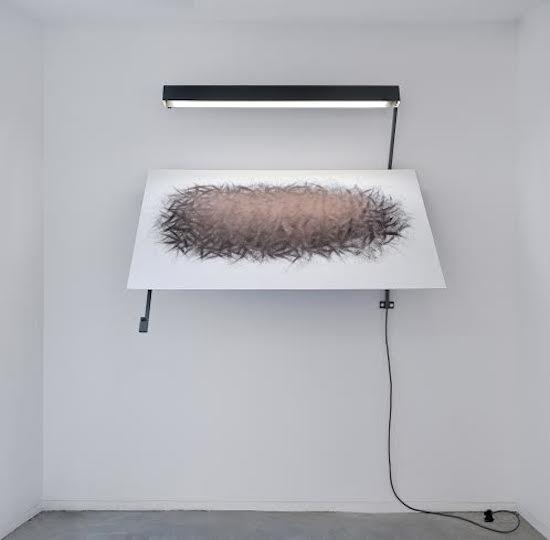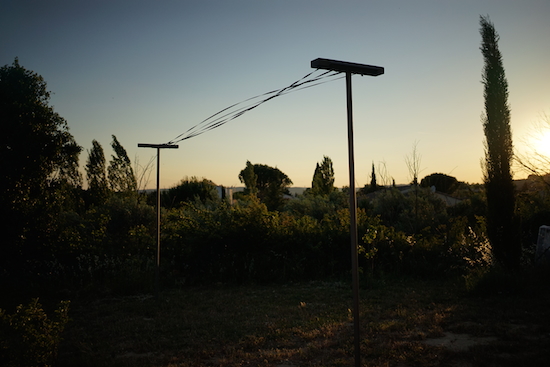Images courtesy of Eric Mouchet
Saint-Germain-Des-Près might be billed as the cultural heart of Paris, but it’s eerily quiet. The history books describe it as home of highfalutin intellectual debate, but reading Sartre, de Beauvoir and Bernard-Henry Lévy is largely a silent, solitary pursuit. The sonic background is occasionally provided by wafts of vague literary chatter from pavement cafés or most often by the jabber of lost tourists asking clumsily for directions. Serge Gainsbourg, the radical pop star and cultural phenomenon who lived on rue de Verneuil, and brought some real life to the Left Bank, is long dead, his former home padlocked and turned into a mawkish silent mausoleum.
One young artist, however, is challenging the unsettling calm. Rémi Dal Negro, a native of Lyon, is presenting "SOMA" his first major exhibition in the French capital, and music – in all its varied forms – is at the core of what he does; from the baroque strains of Vivaldi to the techno of Dave Clarke and Ritchie Hawtin. "Music has accompanied me throughout my life. It plays an important role in everything I do: I hunt it out, I collect it, I play it, I organise concerts. It is there right from the start to the finish", Dal Negro says. His gallery describes him as as a "sonic cartographer"; as well as the dialogue his work maintains with repetitive electronic beats and classical strings, he is also fascinated by the sounds that map out our day-to-day existence, ones we might overlook or that are mostly inaudible or imperceptible to the human ear. As this show reveals, his parents’ rickety old Ford Fiesta is also a crucial sonic influence.
The most striking work in this show at the Galerie Eric Mouchet is ‘Primavera’, which brings together both extremes of the range of sounds that interest the artist. The project started with an oversized washing line that Dal Negro erected in the wilds of the French countryside: its lines replaced by large strips of rubber, reminiscent of a loosely-strung guitar. The contraption, or as Dal Negro prefers – ‘instrument’, was wired up to record the sounds produced by the weather and ambient vibrations, effectively ‘playing’ the washing line as it was left in place for a year. The result is a compelling field recording of low frequency shudders, wobbles and what appears to be birdsong, a video of which is on view as part of the show and available as a limited edition vinyl pressing.

The seasonal nature of ‘Primavera’ led Dal Negro to spot the parallels with Antonio Vivaldi’s "Four Seasons" (1725), which also strives to sketch the passage of time, albeit in a more conventionally musical form as a violin concerto. The B-side of Dal Negro’s twelve-inch release includes the juxtaposition of both artworks, his recording of spring overlaying Vivaldi’s in a development or expansion of the piece. This amounts to a gentle, though not disrespectful, subversion of Vivaldi’s work as the authentic sounds of nature are brought back into a relationship with the composer’s own orchestral evocations, backed up by a series of visual prints displaying computer-distorted images of Vivaldi’s portrait. Dal Negro also suggests another way of understanding the final product: "I started learning classical piano when I was five years-old. I had a cassette of the Four Seasons that I used to listen to when we went on holiday, watching the landscape pass by through the window of my parents’ car. They had a well-loved 1983 Ford Fiesta which used to vibrate vigorously as it went along. The windows didn’t flit as snugly as they should’ve either, air used to rush into the car and create a sort of industrial vibrato. When I created the washing line, I realised I was unconsciously rediscovering this lost childhood memory".
Another work, ‘Sans Titre’, sits alongside ‘Primavera’ in the gallery and celebrates Dal Negro’s love of techno. A drawing, or effectively a large, dense scribbled mass of hatchings, produced by ballpoint pen is displayed angled on a metal frame, evoking a nightclub DJ rig. The drawing itself is, for the artist, an attempt to reflect, or transcribe, the almost trance-like, state he felt listening to the tracks of artists such as Aphex Twin, Plastikman and Cari Lekebusch throughout the 1990s: "this piece is homage to these peerless DJs", he stresses. A full tracklisting is displayed via an MP3 player bundled into the sculpture. It generates a strange effect. While the viewer can fully experience ‘Primavera’, Dal Negro’s homage feels more personal, even private, and the observer can only speculate as to the nature of the artist’s intense techno-fuelled state of mind.
Two backlit images, "A travers le soufflé", also demonstrate Dal Negro’s sonic influences and how his work explores unlistenable noise. The artist is fascinated by the most powerful noises ever recorded on earth, such as the legendary 1997 undersea Bloop, as well as sounds that cannot be captured: "the sounds that no microphone can record and no speaker and recreate", he adds. Nonetheless, using the mathematical data that exists for such sounds, Dal Negro set about attempting to recreate those of a 6.7 magnitude earthquake and the atomic bomb exploded over Hiroshima. The results were in turn pressed onto vinyl, and photographed with the results on show at "SOMA".
It is perhaps exactly this inexpressible potentiality and, conversely, his desire to express the surprising latent potential of music and noise that makes Dal Negro’s work so interesting. In showing his radical work in the context of a culturally conservative milieu, the Galerie Eric Mouchet, too, had made a bold step by offering a showcase to the rich, yet often overlooked, world of French sound art. Gainsbourg, you’d like to think, would approve of this taking place on is doorstep. Sartre, de Beauvoir and Lévy would probably hate it.
<div class="fb-comments" data-href="http://thequietus.com/articles/17586-live-report-rmi-dal-negro-live-review” data-width="550">


